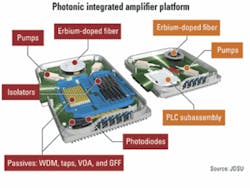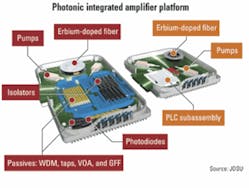by Meghan Fuller Hanna
At last month's European Conference on Optical Communications (ECOC), JDSU (www.jdsu.com) announced that it has brought the benefits of functional integration to a market segment that hasn't seen much innovation in the last decade: optical amplification.
Leveraging JDSU's erbium-doped fiber amplifier (EDFA) capabilities, a breakthrough in planar lightwave circuit (PLC) technology, and the addition of several tunable components, the photonic integrated amplifier (PIA) platform is not only 50% smaller than currently available amplifiers, but it is also the industry's first reconfigurable optical amplifier, reports Craig Iwata, senior director of marketing and business operations at JDSU.In terms of photonic integration, JDSU says it can take up to 50 discrete, passive components and integrate them all on a single chip. "By doing that," says Iwata, "we get all the benefits of functional integration: It's easier for us to manufacture, it's lower in cost, and it's actually higher in performance because we don't have to deal with multiple splices of fiber and individual components."
However, not all the components can be integrated onto the chip. Isolators, for example, must be discrete, but JDSU says it has taken the six individual, discrete isolators found on a typical amplifier and combined them into a single isolator component.
"We essentially attached [this isolator component] on its edge in a way that allows us to get those isolators to act as if they are on the same chip," says Iwata. Again, the benefit is both in performance and manufacturability.
In addition, new waveguide technology simplifies the routing, splitting, and recombining of light signals within the PIA, says the company. Typical PLCs support only one wavelength of light, but amplifiers require two: the 1550-nm signal itself and the 980-nm light that is used to boost the 1550-nm signal. JDSU has developed a new waveguide technology that enables a single PLC to support both the 980- and 1550-nm signals.
That said, photonic integration is only half the story; JDSU's PIA also features a variable pump splitter, a tunable gain flattening filter, and a tilt filter, all of which enable the device to be reconfigurable. In other words, the same PIA could be software-configured for use as a pre-amplifier at receiver sites, as a booster amplifier at transmit locations, and as an inline amplifier between locations that transmit and receive optical signals with a network. As a result, service providers or network equipment manufacturers (NEMs) will require fewer products in inventory, and they will have more flexibility in their deployment options.
The variable pump splitter enables the service provider or NEM to tune how much the signal is boosted at various stages, thereby allowing them to account for changing conditions. The tunable gain flattening filter can be tuned to compensate for impairments, thus ensuring a consistent power level across all amplified channels. Finally, the tilt filter capability provides additional predictability in performance via an active tilt adjustment when a channel load or total signal power changes.
"The reconfigurability aspect allows us to fine-tune the performance, which means our amplifier would have a better noise figure—essentially, it would have less noise," Iwata explains. "The benefit that less noise has to a network would be longer reach. We believe it's up to 15% to 35% longer distance before you would have to do a regen[eration]," he says. "In a DWDM network, that regen[eration] or OEO is a cost."
The PIA platform, which JDSU says will be sold as an amplifier module as well as an integrated function within its Super Transport Blade, is currently sampling with customers and will be available in 2009.

